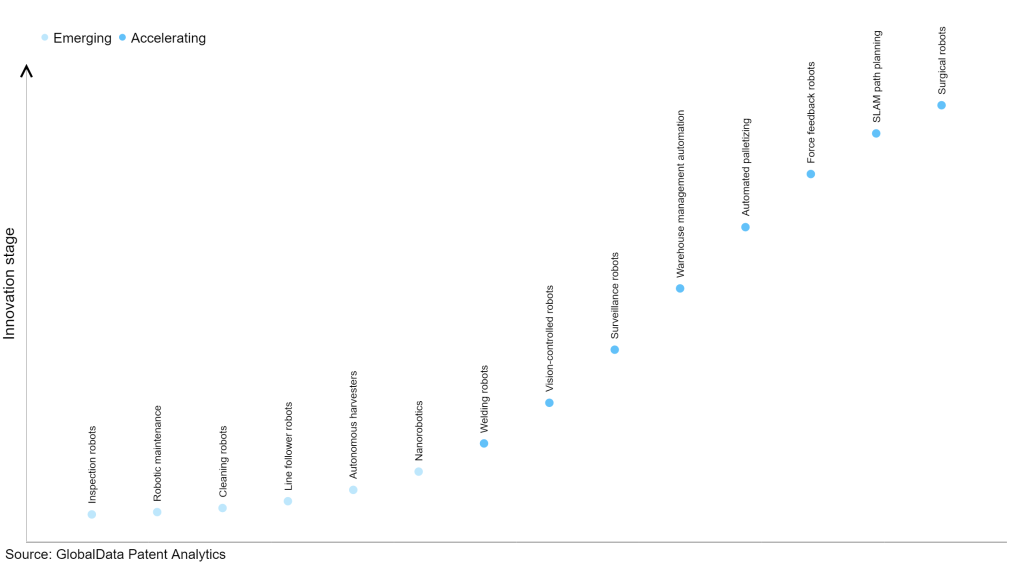The technology industry continues to be a hotbed of patent innovation. Activity is driven by the increasing demand for efficient and high-quality welding processes in industries such as automotive, manufacturing, and construction, coupled with advancements in robotic technologies and artificial intelligence, and growing importance of technologies such as advanced software and sensors to ensure accurate positioning and precise welding, leading to improved efficiency and higher quality welds. In the last three years alone, there have been over 4.1 million patents filed and granted in the technology industry, according to GlobalData’s report on Robotics in technology: welding robots. Buy the report here.

Access deeper industry intelligence
Experience unmatched clarity with a single platform that combines unique data, AI, and human expertise.
However, not all innovations are equal and nor do they follow a constant upward trend. Instead, their evolution takes the form of an S-shaped curve that reflects their typical lifecycle from early emergence to accelerating adoption, before finally stabilizing and reaching maturity.
Identifying where a particular innovation is on this journey, especially those that are in the emerging and accelerating stages, is essential for understanding their current level of adoption and the likely future trajectory and impact they will have.
190+ innovations will shape the technology industry
According to GlobalData’s Technology Foresights, which plots the S-curve for the technology industry using innovation intensity models built on over 1.5 million patents, there are 190+ innovation areas that will shape the future of the industry.
Within the emerging innovation stage, nanorobotics, autonomous harvesters, and line follower robots are disruptive technologies that are in the early stages of application and should be tracked closely. Surgical robots, SLAM path planning, and force feedback robots are some of the accelerating innovation areas, where adoption has been steadily increasing.
Innovation S-curve for robotics in the technology industry

Welding robots is a key innovation area in robotics
Automated welding robots are machines designed to execute welding operations across diverse industries like automotive, aerospace, construction, and manufacturing. They come equipped with specialized welding tools and can be programmed to perform intricate welding tasks with exceptional precision and efficiency.GlobalData’s analysis also uncovers the companies at the forefront of each innovation area and assesses the potential reach and impact of their patenting activity across different applications and geographies. According to GlobalData, there are 150+ companies, spanning technology vendors, established technology companies, and up-and-coming start-ups engaged in the development and application of welding robots.
Key players in welding robots – a disruptive innovation in the technology industry
‘Application diversity’ measures the number of applications identified for each patent. It broadly splits companies into either ‘niche’ or ‘diversified’ innovators.
‘Geographic reach’ refers to the number of countries each patent is registered in. It reflects the breadth of geographic application intended, ranging from ‘global’ to ‘local’.
Among the companies innovating in welding robots, Fanuc is one of the leading patents filers. The company’s patent describes a control device that effectively safeguards against positional shifts of a workpiece on a workpiece-moving apparatus. It achieves this by employing a workpiece-moving apparatus controller that adjusts the time constant, with a longer duration during non-processing tasks, ensuring precise coordination between the robot and workpiece-moving apparatus. Other prominent patent filers in the space include Seurat Technologies and Lincoln Global.
In terms of application diversity, DMG Mori held the top position, while Boeing and General Electric stood in the second and third positions, respectively. By means of geographical reach, Seurat Technologies leads the pack, followed by Salvagnini Italia and 3M Innovative Properties.
Welding robots play a crucial role in modern manufacturing processes, offering a high level of precision and efficiency in welding operations. They significantly enhance productivity, ensure consistent weld quality, and contribute to a safer working environment by reducing human exposure to hazardous welding conditions.
To further understand the key themes and technologies disrupting the technology industry, access GlobalData’s latest thematic research report on Robotics.
Data Insights
From

The gold standard of business intelligence.
Blending expert knowledge with cutting-edge technology, GlobalData’s unrivalled proprietary data will enable you to decode what’s happening in your market. You can make better informed decisions and gain a future-proof advantage over your competitors.







